很多时候图像里有多个目标,不仅想知道它们的类别,还想得到它们在图像中的具体位置。 在计算机视觉里,这类任务称为目标检测(object detection)。
6.1 边界框
边界框(bounding box)用来描述对象的空间位置,形状是矩形并由矩形左上角的以及右下角的x和y坐标决定,或者使用边界框中心的(x,y)轴坐标以及框的宽度和高度来表示。
实现两种坐标的转换,代码如下:
def box_corner_to_center(boxes):
#左上右下表示转换为中心高宽表示
x = (boxes[:,2]+boxes[:,0])/2
y = (boxes[:,3]+boxes[:,1])/2
h = boxes[:,3]-boxes[:,1]
w = boxes[:,2]-boxes[:,0]
boxes = torch.stack((x,y,w,h),axis=-1)
return boxes
def box_center_to_corner(boxes):
#中心高宽表示转换为左上右下
x1 = boxes[:,0]-(boxes[:,2]/2)
y1 = boxes[:,1]-(boxes[:,3]/2)
x2 = boxes[:,0]+(boxes[:,2]/2)
y2 = boxes[:,1]+(boxes[:,3]/2)
boxes = torch.stack((x1,y1,x2,y2),axis=-1)
return boxes这里通过对某个对标重复转换来验证该函数:
dog_bbox,cat_bbox = [10.0, 10.0, 200.0, 240.0], [200.0, 50.0, 320.0, 240.0]
bbox = torch.tensor((dog_bbox,cat_bbox))
box_center_to_corner(box_corner_to_center(bbox)) == bbox运行结果:
tensor([[True, True, True, True], [True, True, True, True]])
实现边框的可视化:
import torch
from d2l import torch as d2l
d2l.set_figsize()
img = d2l.plt.imread('/content/dogcat.png')#这里是你图片的位置
d2l.plt.imshow(img)
def bbox_to_rect(bbox,color):
#bbox是左上和右下的表示
#xy表示左上的坐标
return d2l.plt.Rectangle(
xy = (bbox[0],bbox[1]),width=bbox[2]-bbox[0],
height = bbox[3]-bbox[1],fill=False,edgecolor=color,linewidth=2)
fig = d2l.plt.imshow(img)
fig.axes.add_patch(bbox_to_rect(dog_bbox,'blue'))
fig.axes.add_patch(bbox_to_rect(cat_bbox,'red'))运行结果:
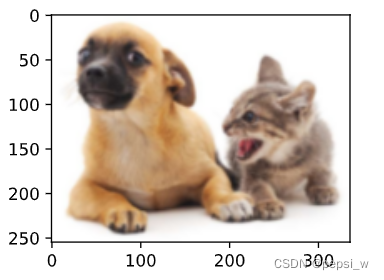
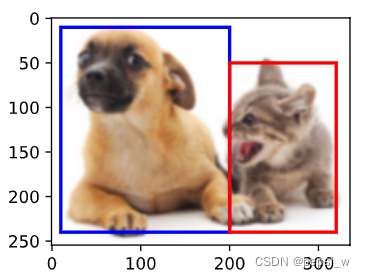
6.2 锚框
以图中某个像素点生成的边界框,称为锚框(anchor box)如下图所示。
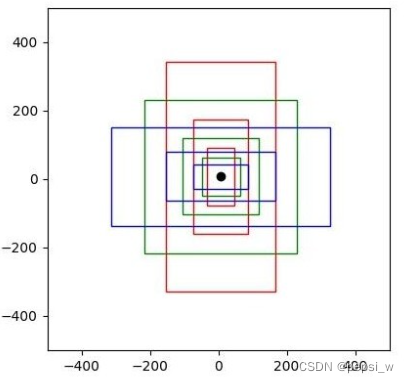
6.2.1 生成多个锚框
假设输入图像的高度为h,宽度为w。 我们以图像的每个像素为中心生成不同形状的锚框:缩放比为s∈(0,1],宽高比为r>0。 那么锚框的宽度和高度分别是和
。 要生成多个不同形状的锚框,让我们设置许多缩放比(scale)取值s1,…,sn和许多宽高比(aspect ratio)取值r1,…,rm。当使用这些比例和长宽比的所有组合以每个像素为中心时,输入图像将总共有whnm个锚框。显然这太多了,所有在实践中只考虑包含s1或r1的组合。此时共有wh(n+m-1)个锚框。
实现输入图像、尺寸列表和宽高比列表,返回所有锚框的代码如下:
def multibox_prior(data, sizes, ratios):#sizes 缩放比 ratios宽高比
"""生成以每个像素为中心具有不同形状的锚框"""
in_height, in_width = data.shape[-2:]
print('in_height',in_height)
print('in_width',in_width)
device, num_sizes, num_ratios = data.device, len(sizes), len(ratios)
boxes_per_pixel = (num_sizes + num_ratios - 1)#一个像素为中心生成的锚框数量
size_tensor = torch.tensor(sizes, device=device)
ratio_tensor = torch.tensor(ratios, device=device)
# 为了将锚点移动到像素的中心,需要设置偏移量。
# 因为一个像素的高为1且宽为1,我们选择偏移我们的中心0.5
offset_h, offset_w = 0.5, 0.5
steps_h = 1.0 / in_height # 在y轴上缩放步长
steps_w = 1.0 / in_width # 在x轴上缩放步长
# 生成锚框的所有中心点
center_h = (torch.arange(in_height, device=device) + offset_h) * steps_h#从第一个像素开始找到每个像素的中心 *steps_h是做归一化处理 都放到0-1之间
center_w = (torch.arange(in_width, device=device) + offset_w) * steps_w
shift_y, shift_x = torch.meshgrid(center_h, center_w, indexing='ij')#meshgrid 生成网格,可以用于生成坐标
# 其中第一个输出张量填充第一个输入张量中的元素,各行元素相同共有第二个输入张量个列;
#第二个输出张量填充第二个输入张量中的元素各列元素相同,共有第一个输入张量个行
#shift_y, shift_x的大小为225*336 即h*w
shift_y, shift_x = shift_y.reshape(-1), shift_x.reshape(-1)#全部搞成一行
# 生成“boxes_per_pixel”个高和宽
# 之后用于创建锚框的四角坐标(xmin,xmax,ymin,ymax)
w = torch.cat((size_tensor * torch.sqrt(ratio_tensor[0]),
sizes[0] * torch.sqrt(ratio_tensor[1:])))* in_height / in_width # 处理矩形输入
h = torch.cat((size_tensor / torch.sqrt(ratio_tensor[0]),
sizes[0] / torch.sqrt(ratio_tensor[1:])))
# 除以2来获得半高和半宽
anchor_manipulations = torch.stack((-w, -h, w, h)).T.repeat(
in_height * in_width, 1) / 2
# 每个中心点都将有“boxes_per_pixel”个锚框,
# 所以生成含所有锚框中心的网格,重复了“boxes_per_pixel”次
out_grid = torch.stack([shift_x, shift_y, shift_x, shift_y],
dim=1).repeat_interleave(boxes_per_pixel, dim=0)
output = out_grid + anchor_manipulations
return output.unsqueeze(0) 为了显示以图像中以某个像素为中心的所有锚框,定义了下面的show_bboxes函数来在图像上绘制多个边界框。
def show_bboxes(axes, bboxes, labels=None, colors=None):
"""显示所有边界框"""
def _make_list(obj, default_values=None):
if obj is None:
obj = default_values
elif not isinstance(obj, (list, tuple)):
obj = [obj]
return obj
labels = _make_list(labels)
colors = _make_list(colors, ['b', 'g', 'r', 'm', 'c'])
for i, bbox in enumerate(bboxes):
color = colors[i % len(colors)]
rect = d2l.bbox_to_rect(bbox.detach().numpy(), color)
axes.add_patch(rect)
if labels and len(labels) > i:
text_color = 'k' if color == 'w' else 'w'
axes.text(rect.xy[0], rect.xy[1], labels[i],
va='center', ha='center', fontsize=9, color=text_color,
bbox=dict(facecolor=color, lw=0))这里对(150,150)这个像素点的所有锚框进行显示:
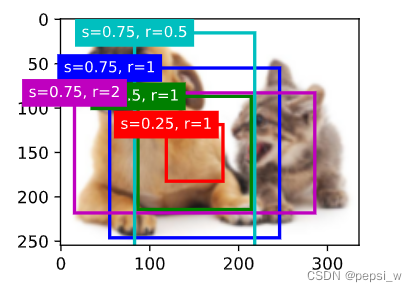
6.2.2交并比(IOU)
即两个边界框相交面积与相并面积之比,如下图所示:

实现代码如下:
def box_iou(boxes1, boxes2):
"""计算两个锚框或边界框列表中成对的交并比"""
box_area = lambda boxes: ((boxes[:, 2] - boxes[:, 0]) *
(boxes[:, 3] - boxes[:, 1]))
# boxes1,boxes2,areas1,areas2的形状:
# boxes1:(boxes1的数量,4),
# boxes2:(boxes2的数量,4),
# areas1:(boxes1的数量,),
# areas2:(boxes2的数量,)
areas1 = box_area(boxes1)
areas2 = box_area(boxes2)
# inter_upperlefts,inter_lowerrights,inters的形状:
# (boxes1的数量,boxes2的数量,2)
inter_upperlefts = torch.max(boxes1[:, None, :2], boxes2[:, :2])
inter_lowerrights = torch.min(boxes1[:, None, 2:], boxes2[:, 2:])
inters = (inter_lowerrights - inter_upperlefts).clamp(min=0)
# inter_areasandunion_areas的形状:(boxes1的数量,boxes2的数量)
inter_areas = inters[:, :, 0] * inters[:, :, 1]
union_areas = areas1[:, None] + areas2 - inter_areas
return inter_areas / union_areas6.2.3 在训练数据中标注锚框
将每个锚框视为一个训练样本。 为了训练目标检测模型,我们需要每个锚框的类别(class)和偏移量(offset)标签,其中前者是与锚框相关的对象的类别,后者是真实边界框相对于锚框的偏移量。 在预测时,我们为每个图像生成多个锚框,预测所有锚框的类别和偏移量,根据预测的偏移量调整它们的位置以获得预测的边界框,最后只输出符合特定条件的预测边界框。
把最接近的真实边界框分配给锚框的算法如下:

代码实现如下:
def assign_anchor_to_bbox(ground_truth, anchors, device, iou_threshold=0.5):
"""将最接近的真实边界框分配给锚框"""
num_anchors, num_gt_boxes = anchors.shape[0], ground_truth.shape[0]
# 位于第i行和第j列的元素x_ij是锚框i和真实边界框j的IoU
jaccard = box_iou(anchors, ground_truth)
# 对于每个锚框,分配的真实边界框的张量
anchors_bbox_map = torch.full((num_anchors,), -1, dtype=torch.long,
device=device)
# 根据阈值,决定是否分配真实边界框
max_ious, indices = torch.max(jaccard, dim=1)
anc_i = torch.nonzero(max_ious >= iou_threshold).reshape(-1)
box_j = indices[max_ious >= iou_threshold]
anchors_bbox_map[anc_i] = box_j
col_discard = torch.full((num_anchors,), -1)
row_discard = torch.full((num_gt_boxes,), -1)
for _ in range(num_gt_boxes):
max_idx = torch.argmax(jaccard)
box_idx = (max_idx % num_gt_boxes).long()
anc_idx = (max_idx / num_gt_boxes).long()
anchors_bbox_map[anc_idx] = box_idx
jaccard[:, box_idx] = col_discard
jaccard[anc_idx, :] = row_discard
return anchors_bbox_map为每个锚框标记类别和偏移量了。 假设一个锚框A被分配了一个真实边界框B。 一方面,锚框A的类别将被标记为与B相同。 另一方面,锚框A的偏移量将根据B和A中心坐标的相对位置以及这两个框的相对大小进行标记。 鉴于数据集内不同的框的位置和大小不同,我们可以对那些相对位置和大小应用变换,使其获得分布更均匀且易于拟合的偏移量。
def offset_boxes(anchors, assigned_bb, eps=1e-6):
"""对锚框偏移量的转换"""
c_anc = d2l.box_corner_to_center(anchors)
c_assigned_bb = d2l.box_corner_to_center(assigned_bb)
offset_xy = 10 * (c_assigned_bb[:, :2] - c_anc[:, :2]) / c_anc[:, 2:]
offset_wh = 5 * torch.log(eps + c_assigned_bb[:, 2:] / c_anc[:, 2:])
offset = torch.cat([offset_xy, offset_wh], axis=1)
return offset
def multibox_target(anchors, labels):
"""使用真实边界框标记锚框"""
batch_size, anchors = labels.shape[0], anchors.squeeze(0)
batch_offset, batch_mask, batch_class_labels = [], [], []
device, num_anchors = anchors.device, anchors.shape[0]
for i in range(batch_size):
label = labels[i, :, :]
anchors_bbox_map = assign_anchor_to_bbox(
label[:, 1:], anchors, device)
bbox_mask = ((anchors_bbox_map >= 0).float().unsqueeze(-1)).repeat(
1, 4)
# 将类标签和分配的边界框坐标初始化为零
class_labels = torch.zeros(num_anchors, dtype=torch.long,
device=device)
assigned_bb = torch.zeros((num_anchors, 4), dtype=torch.float32,
device=device)
# 使用真实边界框来标记锚框的类别。
# 如果一个锚框没有被分配,我们标记其为背景(值为零)
indices_true = torch.nonzero(anchors_bbox_map >= 0)
bb_idx = anchors_bbox_map[indices_true]
class_labels[indices_true] = label[bb_idx, 0].long() + 1
assigned_bb[indices_true] = label[bb_idx, 1:]
# 偏移量转换
offset = offset_boxes(anchors, assigned_bb) * bbox_mask
batch_offset.append(offset.reshape(-1))
batch_mask.append(bbox_mask.reshape(-1))
batch_class_labels.append(class_labels)
bbox_offset = torch.stack(batch_offset)
bbox_mask = torch.stack(batch_mask)
class_labels = torch.stack(batch_class_labels)
return (bbox_offset, bbox_mask, class_labels)当有许多锚框时,可能会输出许多相似的具有明显重叠的预测边界框,都围绕着同一目标。 为了简化输出,可以使用非极大值抑制(non-maximum suppression,NMS)合并属于同一目标的类似的预测边界框。 对于一个预测边界框B,目标检测模型会计算每个类别的预测概率。 假设最大的预测概率为p,则该概率所对应的类别B即为预测的类别。 在同一张图像中,所有预测的非背景边界框都按置信度降序排序,以生成列表L。

代码实现:
def nms(boxes, scores, iou_threshold):
"""对预测边界框的置信度进行排序"""
B = torch.argsort(scores, dim=-1, descending=True)
keep = [] # 保留预测边界框的指标
while B.numel() > 0:
i = B[0]
keep.append(i)
if B.numel() == 1: break
iou = box_iou(boxes[i, :].reshape(-1, 4),
boxes[B[1:], :].reshape(-1, 4)).reshape(-1)
inds = torch.nonzero(iou <= iou_threshold).reshape(-1)
B = B[inds + 1]
return torch.tensor(keep, device=boxes.device)
def multibox_detection(cls_probs, offset_preds, anchors, nms_threshold=0.5,
pos_threshold=0.009999999):
"""使用非极大值抑制来预测边界框"""
device, batch_size = cls_probs.device, cls_probs.shape[0]
anchors = anchors.squeeze(0)
num_classes, num_anchors = cls_probs.shape[1], cls_probs.shape[2]
out = []
for i in range(batch_size):
cls_prob, offset_pred = cls_probs[i], offset_preds[i].reshape(-1, 4)
conf, class_id = torch.max(cls_prob[1:], 0)
predicted_bb = offset_inverse(anchors, offset_pred)
keep = nms(predicted_bb, conf, nms_threshold)
# 找到所有的non_keep索引,并将类设置为背景
all_idx = torch.arange(num_anchors, dtype=torch.long, device=device)
combined = torch.cat((keep, all_idx))
uniques, counts = combined.unique(return_counts=True)
non_keep = uniques[counts == 1]
all_id_sorted = torch.cat((keep, non_keep))
class_id[non_keep] = -1
class_id = class_id[all_id_sorted]
conf, predicted_bb = conf[all_id_sorted], predicted_bb[all_id_sorted]
# pos_threshold是一个用于非背景预测的阈值
below_min_idx = (conf < pos_threshold)
class_id[below_min_idx] = -1
conf[below_min_idx] = 1 - conf[below_min_idx]
pred_info = torch.cat((class_id.unsqueeze(1),
conf.unsqueeze(1),
predicted_bb), dim=1)
out.append(pred_info)
return torch.stack(out)实验结果如下,左边为使用NMS前,右边为使用NMS后,只保留了最大置信度的锚框。
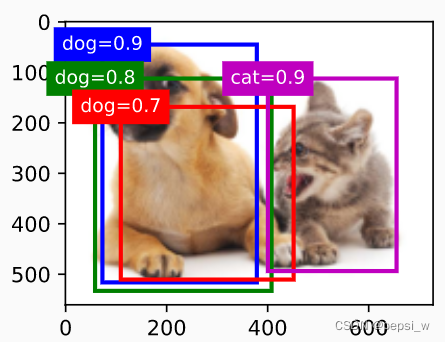






















 1290
1290











 被折叠的 条评论
为什么被折叠?
被折叠的 条评论
为什么被折叠?








